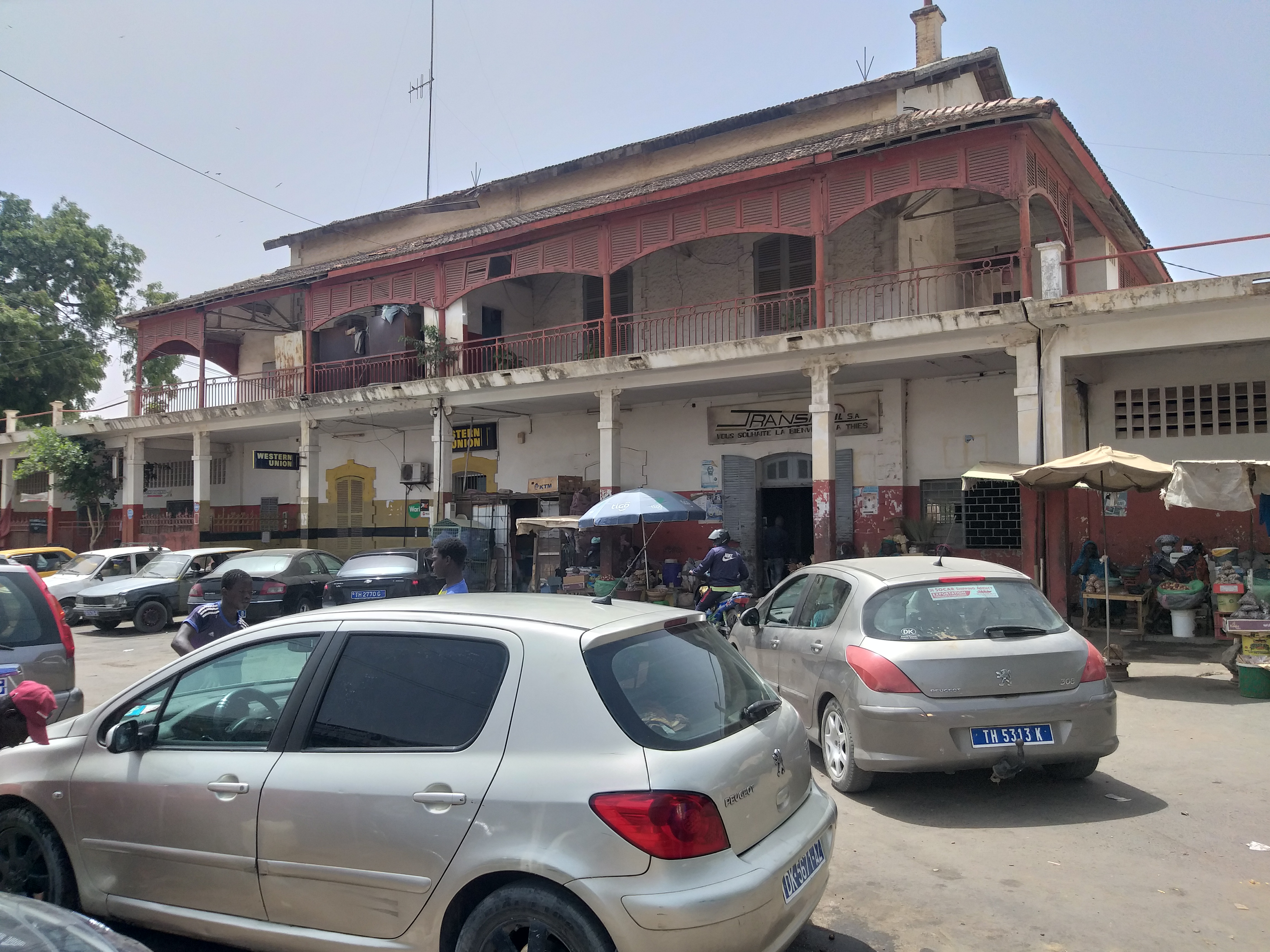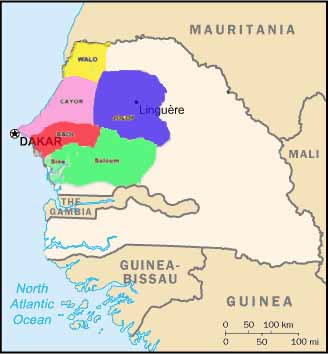|
Tivouane
Tivaouane or Tivawan ( wo, Tiwaawan; french: Tivaouane) is a city located in the Thiès Region of Senegal. History Tivaouane was part of the Wolof kingdom of Cayor, and was at one time its capital. It was first described to Europeans in the 15th century by Venetian explorer Luigi Cada-Mosto. In 1904, it was the fifth largest city in Sénégal after Saint-Louis, Dakar, Rufisque and Gorée. It is also one of the sacred places of the Tijaniyya Sufi brotherhood. Each week, followers come to visit the tombs of religious leaders, especially that of El-Hadji Malick Sy. Visitors flock each year to celebrate the birth of the prophet Muhammad in a festival called the Maouloud (or ''Gamou'', in Wolof, a word borrowed from one of the Serer religious festivals). The influence of the Muslim brotherhoods of Senegal helps to explain the dramatic demographic growth of the city, which had a population of less than 7900 in 1960. In 2003, the mosque and zawia (Muslim school) of El-Hadji Ma ... [...More Info...] [...Related Items...] OR: [Wikipedia] [Google] [Baidu] |
Regions Of Senegal
Senegal is subdivided into 14 regions (French: ''régions'', singular''région''), each of which is administered by a ''Conseil Régional'' (pl.: ''Conseils Régionaux'') elected by population weight at the arrondissement An arrondissement (, , ) is any of various administrative divisions of France, Belgium, Haiti, certain other Francophone countries, as well as the Netherlands. Europe France The 101 French departments are divided into 342 ''arrondissements'' ... level. Senegal is further subdivided into 45 departments, 103 arrondissements (neither of which have administrative function) and by ''collectivités locales'' (the 14 ''regions'', 110 ''communes'', and 320 ''communautés rurales'') which elect administrative officers. from Union des ''Associations d’ Elus Locaux (UAEL) du ... [...More Info...] [...Related Items...] OR: [Wikipedia] [Google] [Baidu] |
Malick Sy
El-Hadji Malick Sy ( ff, Allaaji Maalik Si, 1853–1922) was a Senegalese religious leader and teacher in the Tijaniyya Sufi Malikite and Ash'arite brotherhood. Life Born in Gaya, northern Senegal, to a Fulani family, El-Hadji Malick Sy traveled to Mauritania, then to Saint-Louis, Senegal in 1884 as a religious student. He traveled to Mecca, then returned to teach at Louga and before establishing a ''zāwiya'' (religious center) at Tivaouane he settled permanently in 1898 in tivaouane in 1902 following guidance received from his father in law Mor Massamba Diery Dieng father of his wife Sokhna Yacine Dieng and at the invitation of local leader Djibril Guèye, which became a center for Islamic education and culture under his leadership. In Senegal's Wolof country, especially the northern regions of Kajoor and Jolof, the Tijānī Order was spread primarily by El-Hajj Malick Sy. Legacy After his death on 27 June 1922, Malick Sy was succeeded by his son Seydi Ababacar Sy as the ... [...More Info...] [...Related Items...] OR: [Wikipedia] [Google] [Baidu] |
Arachide Oil
Peanut oil, also known as groundnut oil or arachis oil, is a vegetable oil derived from peanuts. The oil usually has a mild or neutral flavor but, if made with roasted peanuts, has a stronger peanut flavor and aroma. It is often used in American, Chinese, Indian, African and Southeast Asian cuisine, both for general cooking, and in the case of roasted oil, for added flavor. Peanut oil has a high smoke point relative to many other cooking oils, so it is commonly used for frying foods. History Due to war shortages of other oils, use of readily available peanut oil increased in the United States during World War II. Production Uses Unrefined peanut oil is used as a flavorant for dishes akin to sesame oil. Refined peanut oil is commonly used for frying volume batches of foods like French fries and has a smoke point of 450 °F/232 °C. Biodiesel At the 1900 Paris Exhibition, the Otto Company, at the request of the French Government, demonstrated that peanut oil c ... [...More Info...] [...Related Items...] OR: [Wikipedia] [Google] [Baidu] |
Wolof People
The Wolof people () are a West African ethnic group found in northwestern Senegal, the Gambia, and southwestern coastal Mauritania. In Senegal, the Wolof are the largest ethnic group (~43.3%), while elsewhere they are a minority. They refer to themselves as ''Wolof'' and speak the Wolof language, in the West Atlantic branch of the Niger–Congo family of languages. Their early history is unclear. The earliest documented mention of the Wolof is found in the records of 15th-century, Portuguese-financed Italian traveller Alvise Cadamosto, who mentioned well-established Islamic Wolof chiefs advised by Muslim counselors. The Wolof belonged to the medieval-era Wolof Empire of the Senegambia region. Details of the pre-Islamic religious traditions of the Wolof are unknown, and their oral traditions state them to have been adherents of Islam since the founding king of Jolof. However, historical evidence left by Islamic scholars and European travelers suggest that Wolof warriors an ... [...More Info...] [...Related Items...] OR: [Wikipedia] [Google] [Baidu] |
Thiès
Thiès (; ar, ثيس, Ṯyass; Noon: ''Chess'') is the third largest city in Senegal with a population officially estimated at 320,000 in 2005. It lies east of Dakar on the N2 road and at the junction of railway lines to Dakar, Bamako and St-Louis. It is the capital of Thiès Region and is a major industrial city. History Before colonization, the Thiès Plateau was a wooded frontier between the kingdoms of Cayor and Baol inhabited by the Serer-Noon, an ethnic sub-group of the Serer people. The Serer-Noon still inhabit the Thiès-Nones neighborhood of the south-west city today. They speak the Noon language, one of the Cangin languages. The village of Dianxene, belonging to the kingdom of Cayor, was founded on the strategically important plateau in the 17th century. In 1860, it had only 75 inhabitants. The French founded a military post there in 1864, becoming an important force in the city's development ever since. The Spiritans founded a mission there in the late 19th ... [...More Info...] [...Related Items...] OR: [Wikipedia] [Google] [Baidu] |
Dakar
Dakar ( ; ; wo, Ndakaaru) (from daqaar ''tamarind''), is the capital and largest city of Senegal. The city of Dakar proper has a population of 1,030,594, whereas the population of the Dakar metropolitan area is estimated at 3.94 million in 2021. The area around Dakar was settled in the 15th century. The Portuguese established a presence on the island of Gorée off the coast of Cap-Vert and used it as a base for the Atlantic slave trade. France took over the island in 1677. Following the abolition of the slave trade and French annexation of the mainland area in the 19th century, Dakar grew into a major regional port and a major city of the French colonial empire. In 1902, Dakar replaced Saint-Louis as the capital of French West Africa. From 1959 to 1960, Dakar was the capital of the short-lived Mali Federation. In 1960, it became the capital of the independent Republic of Senegal. History The Cap-Vert peninsula was settled no later than the 15th century, by the Lebu ... [...More Info...] [...Related Items...] OR: [Wikipedia] [Google] [Baidu] |
Muslim Brotherhoods Of Senegal
This is a list of Sufi orders (Tariqas) in Senegal (and also the Gambia). They are active Muslim organizations that can also be found in many other parts of Africa and the Islamic world. Their members are mainly Wolofs, Fulas and Tocouleurs. List The four largest Muslim brotherhoods in Senegal are: * The Xaadir (Qādiriyya), the oldest, founded in Baghdad by the Sufi mystic Abdul Qādir al-Jilānī in the 12th century, now pan-Islamic, spread to Senegal in the 18th Century. * The Tijaniyyah, the largest in membership, founded in Fez, Morocco by the Algerian born Cheikh Sīdī 'Aḥmad at-Tijānī. The order is centered in the city of Tivaouane. * The Mourides, the richest and most active, founded by the Islamic leader Cheikh Amadou Bamba (1850–1927) of French West Africa, now Senegal. The order is centered in the city of Touba. * The Layene are a smaller Sufi order, centered at Yoff north of Dakar. External links Review of Sufism and Religious Brotherhoods in Senegal ... [...More Info...] [...Related Items...] OR: [Wikipedia] [Google] [Baidu] |
Serer Religion
The Serer religion, or ''a ƭat Roog'' ("the way of the Divine"), is the original religious beliefs, practices, and teachings of the Serer people of Senegal in West Africa. The Serer religion believes in a universal supreme deity called Roog (or ''Rog''). In the Cangin languages, Roog is referred to as ''Koox'' (or ''Kooh''), Kopé Tiatie Cac, and Kokh Kox. The Serer people are found throughout the Senegambia region. In the 20th century, around 85% of the Serer converted to Islam (Sufism), but some are Christians or follow their traditional religion. Traditional Serer religious practices encompass ancient chants and poems, veneration of and offerings to deities as well as spirits (pangool), initiation rites, folk medicine, and Serer history. Beliefs Divinity The Serer people believe in a supreme deity called Roog (or ''Rog'') and sometimes referred to as ''Roog Sene'' ("Roog The Immensity" or "The Merciful God"). Serer tradition deals with various dimensions of life, ... [...More Info...] [...Related Items...] OR: [Wikipedia] [Google] [Baidu] |
Wolof Language
Wolof (; Wolofal: ) is a language of Senegal, Mauritania, and the Gambia, and the native language of the Wolof people. Like the neighbouring languages Serer and Fula, it belongs to the Senegambian branch of the Niger–Congo language family. Unlike most other languages of the Niger-Congo family, Wolof is not a tonal language. Wolof is the most widely spoken language in Senegal, spoken natively by the Wolof people (40% of the population) but also by most other Senegalese as a second language. Wolof dialects vary geographically and between rural and urban areas. The principal dialect of Dakar, for instance, is an urban mixture of Wolof, French, and Arabic. ''Wolof'' is the standard spelling and may also refer to the Wolof ethnicity or culture. Variants include the older French , , , Gambian Wolof, etc., which now typically refers either to the Jolof Empire or to jollof rice, a common West African rice dish. Now-archaic forms include ''Volof'' and ''Olof''. English is belie ... [...More Info...] [...Related Items...] OR: [Wikipedia] [Google] [Baidu] |
Mawlid
Mawlid, Mawlid an-Nabi ash-Sharif or Eid Milad un Nabi ( ar, المولد النبوي, translit=mawlid an-nabawī, lit=Birth of the Prophet, sometimes simply called in colloquial Arabic , , among other vernacular pronunciations; sometimes , ) is the observance of the birthday of the Islamic prophet Muhammad which is commemorated in Rabi' al-awwal, the third month in the Islamic calendar. 12th Rabi' al-awwal is the accepted date among most of the Sunni scholars, while most Shia scholars regard 17th Rabi' al-awwal as the accepted date, though not all Shias consider it to be this date. It is also called Maouloud in West Africa. The history of this celebration goes back to the early days of Islam when some of the Tabi‘un began to hold sessions in which poetry and songs composed to honour Muhammad were recited and sung to the crowds. It has been said that the first Muslim ruler to officially celebrate the birth of Muhammad in an impressive ceremony was Muzaffar al-Din Gökb ... [...More Info...] [...Related Items...] OR: [Wikipedia] [Google] [Baidu] |








